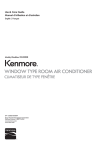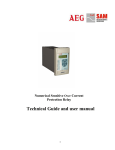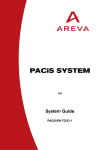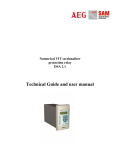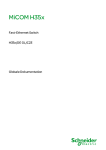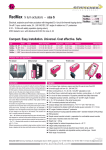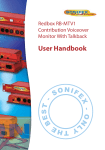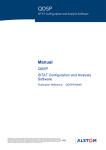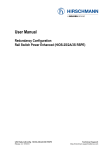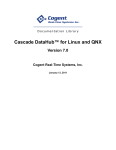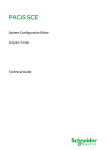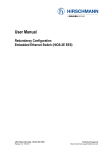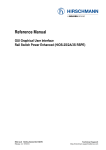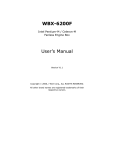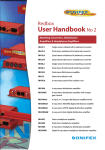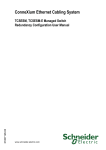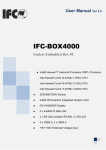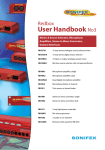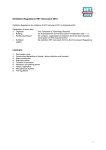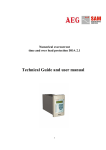Download MiCOM H18x - Schneider Electric
Transcript
MiCOM H18x Redundant Ethernet Unit H18x/EN GL/A11 Global Documentation Global Documentation MiCOM H18x H18x/EN GL/A11 Page 1/49 CONTENTS 1. SCOPE OF THE DOCUMENT 5 2. SAFETY 6 2.1 Safety Information 6 2.2 Introduction 7 2.3 Health and User Protection 7 2.4 Symbols 9 2.5 Installing, commissioning and servicing 10 2.7 De-commissioning and disposal 12 2.8 Technical specifications 13 2.8.1 Protective fuse rating 13 2.8.2 Protective class 13 2.8.3 Installation category 13 2.8.4 Environment 13 2.9 Humidity during storage 13 2.10 Handling of Electronic Equipment 13 2.11 Packing and Unpacking 14 2.12 Guarantees 14 2.13 Copyrights & Trademarks 15 2.13.1 Copyrights 15 2.13.2 Trademarks 15 2.13.3 Attentions regarding use of Schneider Electric products 15 3. INTRODUCTION 16 3.1 MiCOM Ethernet device series and names 16 3.2 MiCOM Ethernet Redundant H18x 17 4. FUNCTIONAL DESCRIPTION 18 4.1 Product Range 18 4.2 Capability 18 4.2.1 PRP Architecture 18 4.2.2 Board Architecture 20 4.3 Power management 20 4.4 Ethernet Ports 21 4.5 Ethernet Management 21 4.5.1 MAC Address Filtering 21 4.5.2 SNMP 21 4.5.3 IEC 62439-3 MIB Structure 21 5. TECHNICAL DATA 23 5.1 MiCOM H18x Range 23 H18x/EN GL/A11 Page 2/49 Global Documentation MiCOM H18x 5.2 Ethernet Port Characteristics 23 5.2.1 100BaseTx Port 23 5.2.2 100BaseFx Multi-Mode Port 23 5.2.3 100BaseFx Single-Mode Port 23 5.3 General Characteristics 24 5.3.1 Protocols 24 5.3.2 Auxiliary Status Indication Relay 24 5.3.3 Ethernet Management 24 5.3.4 Performances 25 5.3.5 Interoperability 25 5.4 Environmental Characteristics 26 6. HUMAN MACHINE INTERFACE 27 6.1 LEDs 28 6.2 Status Output 28 7. INSTALLATION 29 8. CONNECTION 31 8.1 Status output 31 8.2 Ethernet Connection 32 8.2.1 RJ45 connector 32 8.2.2 Ethernet optical fiber 33 9. SETTINGS 34 10. MAINTENANCE 35 10.1 Scope 35 10.2 Recommendation before maintenance operations 35 10.3 Maintenance period 35 10.4 Diagnosis facilities 35 10.5 Method of repair 36 10.5.1 Replacing MiCOM H18x 36 11. LIMITATIONS 37 11.1 Fiber Optic budget calculations 37 11.1.1 Example 1: between devices 38 11.1.2 Example 2: between devices with patch panel 38 11.2 Use constraints 38 12. GLOSSARY AND DEFINITIONS 39 13. ANNEX 41 13.1 Maintenance 41 13.1.1 LEDs 41 13.2 Environmental Characteristics 41 Global Documentation MiCOM H18x H18x/EN GL/A11 Page 3/49 13.2.1 Definitions 41 13.2.2 Insulation 41 13.2.3 Electromagnetic Compatibility 42 13.4.1 Climatic 43 13.4.2 Mechanical 43 13.5 IEC 62439-3 MIB Structure 45 H18x/EN GL/A11 Global Documentation Page 4/49 MiCOM H18x FIGURES FIGURE 1: PRP NETWORK ARCHITECTURE 19 FIGURE 2: MICOM H18X BOARD ARCHITECTURE 20 FIGURE 3: FRAME MAC ADDRESS 21 FIGURE 4: MICOM H18X PCI BOARD 27 FIGURE 5: LEDS AND CONNECTORS 27 FIGURE 6: STATUS CONNECTOR 28 FIGURE 7: RJ45 CONNECTOR 32 FIGURE 8: OPTICAL FIBER - SFP LC SLOT, SFP LC MODULE AND LC FIBBER 33 FIGURE 9: FIBER BUDGET 37 Global Documentation MiCOM H18x 1. H18x/EN GL/A11 Page 5/49 SCOPE OF THE DOCUMENT This document is chapter of MiCOM H18x. It describes the User Manual of the product. Before carrying out any work on the equipment, the user should be familiar with the contents of the next section Safety part of the Schneider Electric Safety Guide: SFTY/4L M/C11 (or later issue). H18x/EN GL/A11 Global Documentation Page 6/49 MiCOM H18x 2. SAFETY 2.1 Safety Information Important information Read these instructions carefully and look at the equipment to become familiar with the device before trying to install, operate, service or maintain it. The following special messages may appear throughout this bulletin or on the equipment to warn of potential hazards or to call attention to information that clarifies or simplifies a procedure. The addition of either symbol to a “Danger” or “Warning” safety label indicates that an electrical hazard exists which will result in personal injury if the instructions are not followed. This is the safety alert symbol. It is used to alert you to potential personal injury hazards. Obey all safety messages that follow this symbol to avoid possible injury or death. DANGER DANGER indicates a hazardous situation which, if not avoided, will result in death or serious injury. WARNING WARNING indicates a hazardous situation which, if not avoided, could result in death or serious injury. CAUTION CAUTION indicates a hazardous situation which, if not avoided, could result in minor or moderate injury. NOTICE NOTICE is used to address practices not related to physical injury. The safety alert symbol shall not be used with this signal word. Please note Electrical equipment should be installed, operated, serviced, and maintained only by qualified personnel. No responsibility is assumed by Schneider Electric for any consequences arising out of the use of this material. A qualified person is one who has skills and knowledge related to the construction, installation, and operation of electrical equipment and has received safety training to recognize and avoid the hazards involved. Global Documentation H18x/EN GL/A11 MiCOM H18x 2.2 Page 7/49 Introduction This Safety Section and the relevant equipment documentation provide information on protective handling, commissioning and testing of this equipment. Documentation for equipment ordered from Schneider Electric is des-patched separately from manufactured goods and may not be received at the same time. Therefore this section is provided to help ensure that printed information which may be present on the equipment is understood by the recipient. The technical data in this Safety Section is typical only; see the technical data section of the relevant equipment documentation for data specific to a particular piece of equipment. Before carrying out any work on the equipment the user should be familiar with the contents of this Safety Section and the ratings on the equipment’s rating label. Reference should be made to the external connection diagram before the equipment is installed, commissioned or serviced. Language specific, self-adhesive User Interface labels are provided in a bag for some equipment. 2.3 Health and User Protection The information in the Safety Section of the equipment documentation is intended to help ensure that equipment is properly installed and handled in order to maintain it in a nominal condition. It is assumed that everyone who will be associated with the equipment will be familiar with the contents of this Safety Section. When electrical equipment is in operation, dangerous voltages will be present in certain parts of the equipment. Bypassing safety messages may lead to improper use and may endanger personnel and equipment and also cause personal injury or physical damage. WARNING EQUIPEMENT DAMMAGE Before working in the terminal strip area, the equipment must be isolated Failure to follow these instructions can result in death, serious injury, or equipment damage. Proper operation of the equipment depends on appropriate shipping and handling, storage, installation and commissioning, and on careful operation, maintenance and servicing. For this reason only qualified personnel may work on or operate the equipment. Qualified personnel are individuals who: Are familiar with the installation, commissioning, and operation of the equipment and of the system to which it is being connected, Are able to perform switching operations in accordance with accepted engineering practices and are authorised to energize and de-energize equipment and to isolate, ground, and label it, Are trained in the care and use of apparatus in accordance with engineering practices, Are trained in emergency procedures (first aid). The equipment documentation gives instructions for its installation, commissioning, and operation. However, the manuals cannot cover conceivable circumstances or include detailed information on topics. In the event of questions or specific problems, it H18x/EN GL/A11 Page 8/49 Global Documentation MiCOM H18x recommended to not taking any action without proper authorization. Contact the appropriate Schneider Electric Technical sales office and request the necessary information. Global Documentation MiCOM H18x 2.4 H18x/EN GL/A11 Page 9/49 Symbols For protective reasons the following symbols, which may be used on the equipment or referred to in the equipment documentation, should be understood before it is installed or commissioned. Caution: refer to equipment documentation Caution: risk of electric shock Protective Conductor Terminal (Note 2) Functional/Protective Conductor Terminal ( Note 3) Caution: risk of injury ___________________________________________________________________________ Note 1 THE TERM EARTH USED THROUGHOUT THIS TECHNICAL MANUAL IS THE DIRECT EQUIVALENT OF THE NORTH AMERICAN TERM GROUND. Note 2 This symbol indicates a Protective Conductor Terminal that must be connected to earth ground before operating the equipment – protects against electrical shock in case of a fault. Note 3 This symbol may also be used for a Protective Conductor Terminal if that terminal is part of a terminal block or sub-assembly e.g. power supply. ___________________________________________________________________________ H18x/EN GL/A11 Global Documentation Page 10/49 2.5 MiCOM H18x Installing, commissioning and servicing WARNING EQUIPEMENT DAMMAGE Follow section Equipment connections recommendations Failure to follow these instructions can result in death, serious injury, or equipment damage. Equipment connections Personnel undertaking installation, commissioning or servicing work for this equipment should be aware of the correct working procedures to help ensure user protection. The equipment documentation should commissioning, or servicing the equipment. be consulted before installing, Terminals exposed during installation, commissioning and maintenance may present a hazardous voltage unless the equipment is electrically isolated. Any disassembly of the equipment may expose parts at hazardous voltage; also electronic parts may be damaged if suitable electrostatic voltage discharge (ESD) precautions are not taken. If there is unlocked access to the rear of the equipment, care should be taken by personnel to avoid electric shock or energy hazards. Voltage and current connections shall be made using insulated crimp terminations to help ensure that terminal block insulation requirements are maintained for user protection. To help ensure that wires are correctly terminated the correct crimp terminal and tool for the wire size should be used. The equipment has to be connected in accordance with the appropriate connection diagram. Protection Class I Equipment - - - Before energizing the equipment it must be earthed using the protective conductor terminal, if provided, or the appropriate termination of the supply plug in the case of plug-connected equipment. The protective conductor (earth) connection must not be removed since the protection against electric shock provided by the equipment would be lost. When the protective (earth) conductor terminal (PCT) is also used to terminate cable screens, etc., it is essential that the integrity of the protective (earth) conductor is checked after the addition or removal of such functional earth connections. For M4 stud PCTs the integrity of the protective (earth) connections should be ensured by use of a locknut or similar. Global Documentation MiCOM H18x H18x/EN GL/A11 Page 11/49 The recommended minimum protective conductor (earth) wire size is 2.5 mm² (3.3 mm² for North America) unless otherwise stated in the technical data section of the equipment documentation, or otherwise required by local or country wiring regulations. The protective conductor (earth) connection must be low-inductance and as short as possible. Connections to the equipment must have a defined potential. Connections that are pre-wired, but not used, should preferably be grounded when binary inputs and output relays are isolated. When binary inputs and output relays are connected to common potential, the pre-wired but unused connections should be connected to the common potential of the grouped connections. Before energizing the equipment, the following should be checked: - Voltage rating/polarity (rating label/equipment documentation), - Protective fuse rating, - Integrity of the protective conductor (earth) connection (where applicable), - Voltage and current rating of external wiring, applicable to the application. Accidental touching of exposed terminals If working in an area of restricted space, such as a cubicle, where there is a risk of electric shock due to accidental touching of terminals which do not comply with IP20 rating, then a suitable protective barrier should be installed. Equipment use If the equipment is used in a manner not specified by the manufacturer, the protection provided by the equipment may be impaired. Removal of the equipment front panel/cover Removal of the equipment front panel/cover may expose hazardous live parts, which must not be touched until the electrical equipment is de-energized. Equipment operating conditions The equipment should be operated within the specified electrical and environmental limits. H18x/EN GL/A11 Global Documentation Page 12/49 MiCOM H18x Insulation and dielectric strength testing Insulation testing may leave capacitors charged up to a hazardous voltage. At the end of each part of the test, the voltage should be gradually reduced to zero, to discharge capacitors, before the test leads are disconnected. Fiber optic communication Optical power meters should be used to determine the operation or signal level of the device. Signal presence shall not be viewed directly. Cleaning The equipment shall be de-energized prior to proceed to cleaning. The equipment may be cleaned using a lint-free cloth dampened with clean water, when no connections are energized. Contact fingers of test plugs are normally protected by petroleum jelly, which should not be removed. 2.7 De-commissioning and disposal De-commissioning The equipment shall be de-energized prior to proceed to de-commissioning. Internal capacitors may be charged up to a hazardous voltage, the voltage should be gradually reduced to zero, to discharge capacitors, before disconnecting. Global Documentation MiCOM H18x 2.8 H18x/EN GL/A11 Page 13/49 Technical specifications Unless otherwise stated in the equipment technical manual, the following data is applicable. 2.8.1 Protective fuse rating The recommended maximum rating of the external protective fuse for equipment is 16 A, high rupture capacity (HRC) Red Spot type NIT, or TIA, or equivalent. The protective fuse should be located as close to the unit as possible. 2.8.2 Protective class IEC 60255-27: 2005 EN 60255-27: 2005 2.8.3 Installation category IEC 60255-27: 2005 EN 60255-27: 2005 2.8.4 Class I (unless otherwise specified in the equipment documentation). This equipment requires a protective conductor (earth) connection to help ensure user protection. Installation category III (Overvoltage Category III): Distribution level, fixed installation. Equipment in this category is qualification tested at 5 kV peak, 1.2/50 µs, 500 , 0.5 J, between supply circuits and earth and also between independent circuits. Environment The equipment is intended for indoor installation and use only. If it is required for use in an outdoor environment then it must be mounted in a specific cabinet or housing allowing it to meet the requirements of IEC 60529 with the classification of degree of protection IP54 (dust and splashing water protected). Pollution Degree - Pollution Degree 2 Altitude - Operation up to 2000m Compliance is demonstrated by reference to safety standards. IEC 60255-27:2005 EN 60255-27: 2005 2.9 Humidity during storage Sustained exposure to high humidity during storage may cause damage to electronics and reduce the lifetime of the equipment. Therefore, once the products have been unpacked, we recommend that they are energized within the three following months. Where electrical equipment is being installed, sufficient time should be allowed for acclimation to the ambient temperature of the environment, before energization. 2.10 Handling of Electronic Equipment A person’s normal movements can easily generate electrostatic potentials of several thousand volts. Discharge of these voltages into semiconductor devices when handling circuits can cause serious damage, which often may not be immediately apparent but the reliability of the circuit will have been reduced. The electronic circuits of Schneider Electric products are immune to the relevant levels of electrostatic discharge when housed in their cases. Do not expose them to the risk of damage by withdrawing modules unnecessarily. Each module incorporates the highest practical protection for its semiconductor devices. However, if it becomes necessary to withdraw a module, the following precautions should be taken in order to preserve the high reliability and long life for which the equipment has been designed and manufactured. 1. Before removing a module, help ensure that you are at the same electrostatic potential as the equipment by touching the case. H18x/EN GL/A11 Global Documentation Page 14/49 MiCOM H18x 2. Handle the module by its front-plate, frame, or edges of the printed circuit board. Avoid touching the electronic components, printed circuit track or connectors. 3. Do not pass the module to any person without first ensuring that you are both at the same electrostatic potential. Shaking hands achieves equipotential. 4. Place the module on an antistatic surface, or on a conducting surface that is at the same potential as you. 5. Store or transport the module in a conductive bag. More information on protective working procedures for electronic equipment can be found in IEC 60147-0F and BS5783. If you are making measurements on the internal electronic circuitry of any equipment in service, it is preferable that you are earthed to the case with a conductive wrist strap. Wrist straps should have a resistance to ground between 500k – 10M Ohms. If a wrist strap is not available you should maintain regular contact with the case to prevent the buildup of static. Instruments used for making measurements should be earthed to the case whenever possible. Schneider Electric strongly recommends that detailed investigations on the electronic circuitry, or modification work, should be carried out in a Special Handling Area such as described in IEC 60147-0F or BS5783. 2.11 Packing and Unpacking MiCOM Hxxx devices are packaged separately in their own cartons and shipped inside outer packaging. Use special care when opening the cartons and unpacking the device, and do not use force. In addition, make sure to remove from the inside carton the supporting documents supplied with each individual device and the type identification label. The design revision level of each module included with the device in its as-delivered condition can be determined from the list of components. This list should be carefully saved. After unpacking the device, inspect it visually to make sure it is in proper mechanical condition. If MiCOM H1xx device needs to be shipped, both inner and outer packaging has to be used. If the original packaging is no longer available, make sure that packaging conforms to ISO 2248 specifications for a drop height 0.8m. 2.12 Guarantees The media on which you received Schneider Electric software is guaranteed not to be inoperative executing programming instructions, due to be inoperative in materials and workmanship, for a period of 90 days from date of shipment, as evidenced by receipts or other documentation. Schneider Electric will, at its option, repair or replace software media that do not execute programming instructions if Schneider Electric receives notice of such detected error during the warranty period. Schneider Electric does not guarantee that the operation of the software shall be uninterrupted or error free. A Return Material Authorization (RMA) number must be obtained from the factory and clearly marked on the package before any equipment acceptance for guarantee work. Schneider Electric will pay the shipping costs of returning to the owner any parts that are covered by warranty. Schneider Electric believes that the information in this document is accurate. The document has been carefully reviewed for technical accuracy. In the event that technical or typographical errors exist, Schneider Electric reserves the right to make changes to subsequent editions of this document without prior notice to holders of this edition. The reader should consult Schneider Electric if errors are suspected. In no event shall Schneider Electric be liable for any damages arising from or related to this document or the information contained in it. Except as specified herein, Schneider Electric makes no guarantees, express or implied and specifically disclaims any guarantee of merchantability or suitability for a particular purpose. Customer's rights to recover damages caused by detected error or negligence on the part Global Documentation MiCOM H18x H18x/EN GL/A11 Page 15/49 Schneider Electric shall therefore be limited to the amount paid by the customer. Schneider Electric will not be liable for damages resulting from loss of data, profits, use of products or incidental or consequential damages even if advised of the possibility thereof. This limitation of the liability of Schneider Electric will apply regardless of the form of action, whether in contract or tort, including negligence. Any action against Schneider Electric must be brought within one year after the cause of action accrues. Schneider Electric shall not be liable for any delay in performance due to causes beyond its reasonable control. The warranty provided herein does not cover damages, inoperative, malfunctions, or service detected faults caused by owner's detected fault to follow Schneider Electric installation, operation, or maintenance instructions; owner's modification of the product; owner's abuse, misuse, or negligent acts; and power detected faults or surges, fire, flood, accident, actions of third parties, or other events outside reasonable control. Note: For the hardware guarantees, please refer to Schneider Electric General guarantees conditions. 2.13 Copyrights & Trademarks 2.13.1 Copyrights Under the copyright laws, this publication may not be reproduced or transmitted in any form, electronic or mechanical, including photocopying, recording, storing in an information retrieval system, or translating, in whole or in part, without the prior written consent of Schneider Electric. 2.13.2 Trademarks PACiS is a trademark of Schneider Electric. Product and company names mentioned herein are trademarks or trade names of their respective companies. 2.13.3 Attentions regarding use of Schneider Electric products Schneider Electric products are not designed with components and testing for a level of reliability suitable for use in connection with surgical implants or as critical components in any life support systems whose detected fault to perform can reasonably be expected to cause significant injuries to a human. In any application, including the above, reliability of operation of the software products can be impaired by adverse factors, including - but not limited to - fluctuations in electrical power supply, computer hardware malfunctions, computer operating system malfunctions, software suitability, suitability of compilers and development software used to develop an application, installation errors, software and hardware compatibility problems, malfunctions or detected faults of electronic monitoring or control devices, transient detected faults of electronic systems (hardware and/or software), unanticipated uses or misuses, or errors by the user or application designer (adverse factors such as these are collectively termed "System detected fault "). Any application where a system detected fault would create a risk of harm to property or persons (including the risk of bodily injuries and death) should not be reliant solely upon one form of electronic system, due to the risk of system detected fault. To avoid damage, injury or death, the user or application designer must take reasonable steps to protect against system detected fault, including - but not limited - to back-up or shut-down mechanisms, not because the end-user system is customized and differs from Schneider Electric testing platforms but also because a user or application designer may use Schneider Electric products in combination with other products. These actions cannot be evaluated or contemplated by Schneider Electric. Thus, the user or application designer is ultimately responsible for verifying and validating the suitability of Schneider Electric products whenever they are incorporated in a system or application, even without limitation of the appropriate design, process and protective levels of such system or application. H18x/EN GL/A11 Global Documentation Page 16/49 3. MiCOM H18x INTRODUCTION The MiCOM Ethernet range is designed to deal with the needs of a wide range of electric plants. Emphasis has been placed on strong compliance with standards, scalability, modularity and open architecture. These features facilitate the use of MiCOM products in several applications, from the most basic to the most demanding. They also help ensure interoperability with existing components. The Schneider Electric philosophy is to provide a range of Ethernet products such as device, taking into account the compulsory requirements of electrical substations, including power supply and immunity to environmental constraints. It provides also solutions to specific requirements such as network redundancy management. Each of these products can be used independently, or can be integrated to form a PACiS system, which is a Digital Control System (DCS). 3.1 MiCOM Ethernet device series and names Driven by calls from over the world for advanced substation applications for Automation control and monitoring, Schneider Electric is committed to provide a comprehensive range of Ethernet-based products that respond to our customers' needs. Standard Ethernet products rarely meet the constraints of electrical plants: environmental, power supply, redundancy, etc. The new MiCOM Hxxx series has been specially tailored to respond to these requirements, and is compatible with the PACiS system. The MiCOM Hxxx range is designed to address different kinds of architectures and installations. The MiCOM H series is split into five major ranges: Device Serie MiCOM Hx4x SWU Description Ethernet Switches designed for Simple Ethernet Star architecture MiCOM Hx5x SWR Ethernet Switches designed for Redundant Optical Ring architecture with fast Self-Healing Protocol (SHP) MiCOM Hx6x SWD Ethernet Switches designed for Dual Ethernet Star architecture with Dual Homing Protocol (DHP) MiCOM Hx8x REU Redundant Ethernet Unit designed for Simple Ethernet Star architecture with Parallel Redundancy Protocol (PRP The actual existing devices names are: Device Name MiCOM H1xx MICOM REU20x Description PCI Board (the power supply from PCI BUS) PRP Redundant Ethernet Unit Board inside a C264 calculator Global Documentation MiCOM H18x 3.2 H18x/EN GL/A11 Page 17/49 MiCOM Ethernet Redundant H18x The MiCOM H18x range is a set of devices with a PCI 2.2 connector embedded with the PRP protocol to provide the Ethernet Redundancy (IEC 62439-3). The MiCOM H18x range relies on managed devices that are easy to install and operate in an electrical plant environment (IEC 61000-4, IEC 60255-5 & IEC 61850-3). MiCOM H18x supports 100BaseTX and 100BaseFX (IEEE 802.3 standard). The MiCOM H18x is a plug-and-play device, all its configuration and settings are performed in the factory. H18x/EN GL/A11 Global Documentation Page 18/49 4. MiCOM H18x FUNCTIONAL DESCRIPTION The MiCOM H18x board is a Redundant Ethernet Unit compliant with the electric plant environment. It supports standardized redundant protocols PRP (IEC62439-3) and allows to PC a PRP networking connection (100Mbps with Full Duplex mode) and supports synchronized protocol SNMP. The board is compliant with IEC61850-3 standard and PACiS standard. The configuration and settings of the MiCOM H18x are performed in the factory. 4.1 Product Range The MiCOM H18x range is dedicated to ultra fast Redundant Ethernet star or ring topologies, and is defined by the type of Ethernet connector. It has an Ethernet copper link via only one RJ45 connector, with speed automatically adjusted by the external emitters to 100 Mbps. The Ethernet copper link is limited in distance and subject to interference. The redundant Ethernet star or ring are based on optical inter-switch connection. The user has the choice between using Multi-Mode Fiber optic for short distances or Single- Mode Fiber Optic for long distances. The table below describes the MICOM H18x range, detailing the connectivity used. Model Description MiCOM H182 Ethernet Redundant Board IEC62439-3 (PRP) Multi-Mode fiber MiCOM H184 Ethernet Redundant Board IEC62439-3 (PRP) Single-Mode fiber Ethernet Redundant Board IEC62439-3 (PRP) MiCOM H183 (optional) Ethernet Redundant Board IEC62439-3 (PRP) H183 Optional Multi-Mode (link A/B) + SingleMode (link B/A) Ethernet Redundant Board IEC62439-3 (PRP) 4.2 Capability 4.2.1 PRP Architecture Connectors 1 x RJ45 2 x LC The PRP protocol manages a redundancy network. Parallel Redundancy Protocol (PRP) is a standard data communication network. Protocol allows systems to overcome any single network error without affecting the data transmission. In case detected error of the optical fiber connection between two devices, the network connection can be maintained. PRP protocol can be applied to most Industrial Ethernet applications since it is independent of the protocols and provides seamless failover. It is implemented in the end devices and two independent paths are configured to exist between these end devices. The LAN networks (LAN_A, LAN_B) are completely separated and are assumed to be defect-independent. Redundancy management interface: MiCOM H18x (DAN on figure below) allows to track the health of each LAN, and especially to detect error early when the error rate increases. It keeps for each port a counter of received messages and of messages received with an error. The LAN statuses appear as SNMP objects; this allows using the same tools for managing the nodes and the bridges (see IEC-62439-3 MIB OID draft description). Global Documentation H18x/EN GL/A11 MiCOM H18x Page 19/49 Source ETHERNET Link B-Frame RedBox DAN A-Frame SAN Local Area Network LAN_A B-Frame A-Frame B-Frame DAN SAN Local Area Network LAN_B RedBox SAN Destination VDAN FIGURE 1: PRP NETWORK ARCHITECTURE DEVICE DESCRIPTION The two LANs, named LAN_A and LAN_B are identical in protocol at the MAC level, but they can differ in performance and topology (ring or star) MORE The Dual Attached Node (DAN) is connected to both LANs. Each DAN has two ports that operate in parallel. MiCOM H18x LAN The Virtual Dual Attached Node (VDAN), node that is connected to both networks by a RedBox. A VDAN appears to other nodes like a DAN. Redundancy Box, bridging device to attach a network of VDANs or a single VDAN RedBox Single Attached Node (SAN), normal node with only one network interface. LAN Bridge H18x/EN GL/A11 Global Documentation Page 20/49 4.2.2 MiCOM H18x Board Architecture Board Bus TIMER FLASH SDRAM POWER SUPPLY Port I LEDs Copper Port HOST (100 MBits) Phy I RJ45 Connector Phy A Fiber Optic Transceiver A Optical Port A (100 MBits) Phy B Fiber Optic Transceiver B Optical Port B (100 MBits) FPGA Alarm connector Port A RELAYs NIOS II Port B Setting IP Address Setting Protocol FIGURE 2: MICOM H18x BOARD ARCHITECTURE MiCOM H18x board offers 3 x MII 100Mbps, Full Duplex Ethernet connections: 1 internal port used by the Host network (Interlink) 2 external ports connected to the Redundant network (optical) H18x board implements redundant protocols defined by the IEC 62439-3 (PRP): PRP for independent LAN attachment like dual star network topology H18x board has 1 x copper (RJ45) and 2 x optical connections (Multi-Mode or Single-Mode). Internal LEDs and Status contact are defined in standard to check that product operates correctly. 4.3 Component Usage TIMER Oscillator Master Clock FLASH Memory for Saving FPGA firmware and board configuration SDRAM Memory for Processor program execution NIOS II 32-bit embedded RISC processor RJ45 Connector Ethernet non redounded network 1 x MII port for connexion to the HOST. Optical Port A and B Ethernet redounded network 2 x MII ports for connexion to the external redounded network. LEDs Board and communication link status Relays Status Indication Power management If Ethernet cable is not connected on port, most of the circuitry for that port is disabled in order to save power. Global Documentation H18x/EN GL/A11 MiCOM H18x Page 21/49 On the contrary, the power consumption is 3W when the board is transferring data. 4.4 Ethernet Ports The MiCOM H18x has a 100 Mbps speed transmission and full duplex only. The board has 2 Ethernet SFP FX ports. Fibber connector is a SFP slot and SFP modules for LC 1310 nm. Board has one FX port in Single-Mode and one FX port in Multi-Mode. The Host port is a RJ45 connector and dedicated to PC RJ45 link. 100BaseTX The copper port (RJ45) is full duplex at 100 Mbps only. The fiber optic ports are full duplex at 100 Mbps only. 100BaseFX 4.5 Ethernet Management 4.5.1 MAC Address Filtering The microcontroller filters frames according to their Mac destination address. Destination Mac address is mask filtered: if no filter is configured, frames are forwarded (duplicates excluded) but if one filter is set, only frames with masked destination Mac addresses are forwarded. 14 filters are available: 8 filters masks for the port Interlink 6 filters masks for the embedded microcontroller FIGURE 3: FRAME MAC ADDRESS This example of setting MAC Address filtering Filter mask (bin) Filter MAC (hex) Accepted MAC (hex) 11 11 11 11 10 00 00 15 12 15 77 83 00 15 12 15 7X XX Note: The two filter mask and filter MAC are configured in factory. 4.5.2 SNMP Simple Network Management Protocol (SNMP) is an Internet-standard protocol to manage devices on IP networks. Devices that typically support SNMP include routers, switches, servers, workstations, printers, modem racks, and more. SNMP relies on a Management Information Base (MIB) that contains information about parameters to supervise. 4.5.3 IEC 62439-3 MIB Structure A MIB's format is a tree structure, with each node identified by a numerical Object IDentifier (OID). Each OID identifies a variable that can be read or set via SNMP with the appropriate software. The information in MIBs is standardized. MiCOM H18x supports the standard 62439-3 MIB; for detail, please refer on ANNEX. H18x/EN GL/A11 Page 22/49 4.5.3.1 Global Documentation MiCOM H18x SNMP Client Software Various “SNMP Client software” tools can be used with the MiCOM H18x range. Schneider Electric does not provide such tools. Any MIB Browser Software performing the basic SNMP operations (such as GET, GETNEXT, GETRESPONSE…) can work with the MiCOM range. Global Documentation H18x/EN GL/A11 MiCOM H18x 5. TECHNICAL DATA 5.1 MiCOM H18x Range Page 23/49 Ports 100BaseTx Copper 100BaseFx Multi-Mode fiber 100BaseFx Single-Mode fiber MiCOM H182 1 2 (LC) 0 MiCOM H184 1 0 2 (LC) MiCOM H183 (optional) 1 1 (LC) 1 (LC) 5.2 Ethernet Port Characteristics 5.2.1 100BaseTx Port Connector type Shielded RJ45 jack Manufacturer / Reference 5.2.2 Twisted pair cable Cat 5 Max. cable length with Cat 5 100 m 100BaseFx Multi-Mode Port Fiber port connector LC duplex connector optical Interface Manufacturer / Reference AVAGO HFBR-57E5APZ Center wavelength 1308 nm (Typ.) Optimal fiber cable 62.5/125 µm 50/125 µm Output Optical Power (TX) -20.0 (Min.) -17.0 (Typ.) dBm -23.5 (Min.) -20.0 dBm (Typ.) Receiver Sensitivity (RX) - 31.0 (Min.) dBm -31.0 (Min.) dBm Max. Fiber distance * * See the Fibber optical budget calculation in below section 5.2.3 100BaseFx Single-Mode Port Fiber port connector LC duplex fiber connector Manufacturer / Reference AVAGO AFCT-5765APTZ Center wavelength 1310 nm (Typ.) 1550 nm Optimal fiber cable 9/125 or 10/125 µm Output Optical Power (TX) -15 dBm (Min.) Receiver Sensitivity (RX) -31 dBm (Max.) Max. Fiber distance 15 km * H18x/EN GL/A11 Global Documentation Page 24/49 5.3 General Characteristics 5.3.1 Protocols MiCOM H18x The board is compliant with industrial communication networks for electrical substation automation. The product supports standardized redundant protocols PRP (IEC62439-3) Network management protocol SNMP and Time synchronization protocol SNTP. 5.3.2 Redundancy protocols supported PRP (IEC62439-3) Network management supported SNMP Time Synchronization supported SNTP Level 1 VLAN, level 2 VLAN Not supported Auxiliary Status Indication Relay Manufacturer / Reference OMRON / G6RN-15DC Connector 2 NC contact potential free Rated Voltage 5 VDC Rated Current 8A Max. switching voltage 250 VAC, 30 VDC Max. switching current 8A Mechanical durability 10 000 000 operations minimum Rise time Operate time : 15 ms max Release time : 5 ms max WIRING RECOMMENDATION: DANGER HAZARD OF ELECTRIC SHOCK, EXPLOSION, OR ARC FLASH FOR PROTECTIVE REASONS AND FOR COMPLIANCE WITH THE EUROPEAN COMMISSION LOW VOLTAGE DIRECTIVE (2006/95/EC), THE AUTHORIZED VOLTAGE RATING TO BE APPLIED ON THE "STATUS INDICATION RELAY" IS LIMITED TO 75 VDC OR 50 VAC AND WITH CURRENT NOT EXCEEDING 5 A. Failure to follow these instructions will result in death or serious injury. 5.3.3 Ethernet Management Standards IEEE802.3, 802.3u, 802.3x, 802.1p Forwarding mode Pure Store and Forward Max Memory bandwidth 83% x 100 Mbps Port to Port MAC Address 1 Address learning Automatic Broadcast storm protection Not filtered but adjustable on-demand Illegal frame Dropped per 802.3 Late collision Dropped after 512 bit times Global Documentation H18x/EN GL/A11 MiCOM H18x 5.3.4 5.3.5 Page 25/49 Max clients on interlink 128 Max memory size 128 Mac Address x 6 BYTES Frame buffer size 288 kbits Frame priority management None Filtering Ethernet flow: 8 filters masks for the port Interlink CPU flow: 6 filters masks for the embedded microcontroller (refer section MAC Address Filtering) Performances Maximum frame length allowed 1522 Bytes IEEE 802.3 frame Supported IEC 61850-8-3 frame Supported Power consumption 3W Interoperability The board is compliant with any standardized PRP equipment. H18x/EN GL/A11 Global Documentation Page 26/49 5.4 MiCOM H18x Environmental Characteristics The MiCOM H18x board supports climatic, mechanical and insulation tests complaint with standard IEC61850-3. For tests detail, please refer on ANNEX section Environmental Characteristics Global Documentation H18x/EN GL/A11 MiCOM H18x 6. Page 27/49 HUMAN MACHINE INTERFACE FIGURE 4: MICOM H18x PCI board Status Connector IP address connector Board settings connector L7 L6 L5 L4 K1 Relays K2 L1 A Optical links L2 B LEDs L3 HOST RJ45 link PCI Bus Connector FIGURE 5: LEDs and CONNECTORS H18x/EN GL/A11 Global Documentation Page 28/49 6.1 MiCOM H18x LEDs Two LEDs categories indicate board and communication link status: The PHY driven LEDs show the status and activity for Ethernet Links (L1,L2,L3) The FPGA driven LEDS show the status and activity for board and protocol (L4,L5,L6,L7) At power up, board goes through a series of self-tests. LEDs will flash for a few seconds. Note: Please refer on ANNEX Maintenance section for LEDs L1-L7 description and behavior 6.2 Status Output FIGURE 6: STATUS CONNECTOR The optical redundant links A and B are monitored. If one link comes down the status error is announced by relay contacts. The outputs of the two relays are connected to a status connector. Two status contacts (see K1, K2 on Figure above) are used with one common contact. Relay Contact K1 OPEN Relay Contact K2 OPEN Description Operating CLOSED OPEN OPEN CLOSED CLOSED CLOSED Disconnection on Redundant Ethernet Link A (Loss of light) Disconnection on Redundant Ethernet Link B (Loss of light) Disconnection on Redundant Ethernet Link A and B (Loss of light) or Power OFF. Note: For Connection refer on section Status Indication Contact. Global Documentation H18x/EN GL/A11 MiCOM H18x 7. Page 29/49 INSTALLATION WARNING EQUIPEMENT DAMMAGE Prior to any handling, apply the Electro Static Discharge procedure. Failure to follow these instructions can result in death, serious injury, or equipment damage. To Install the MiCOM H18x PCI board, do following: Note: All pictures below are examples. The target PC could be different following model. Step Action 1 2 Power off the PC and remove the power supply cable Insert H18x board into RACK PCI 3 Screw H18x board 4 Plug H18x board into the free PCI slot H18x/EN GL/A11 Global Documentation Page 30/49 MiCOM H18x 5 Screw PCI RACK to PC 6 7 8 9 10 Plug 2 x SFP transceivers (SFP connectors) Connect 2 x optical fibers (SFP connectors) Connect Ethernet cable (RJ45 connector) Connect Status cable (Status connector) Plug the power supply cable and H18x Power supply on Note1: MiCOM H18x is a “Plug-and-Play” board: No additional driver software is needed. The board’s configuration and settings are performed in factory. Global Documentation H18x/EN GL/A11 MiCOM H18x Page 31/49 8. CONNECTION 8.1 Status output Pin Description 1 COMMON CONTACT 2 COMMON CONTACT 3 STATUS 1 OPEN = NOMINAL CLOSE = Disconnection on Redundant Ethernet Link A 4 STATUS 2 OPEN = NOMINAL CLOSE = Disconnection on Redundant Ethernet Link B TOP 4 1 3 State 2 3 12 4 Note: A closed contact indicates a Disconnection on Redundant Ethernet Link. WIRING RECOMMENDATION: DANGER HAZARD OF ELECTRIC SHOCK, EXPLOSION, OR ARC FLASH FOR PROTECTIVE REASONS AND FOR COMPLIANCE WITH THE EUROPEAN COMMISSION LOW VOLTAGE DIRECTIVE (2006/95/EC), THE AUTHORIZED VOLTAGE RATING TO BE APPLIED ON THE "STATUS INDICATION RELAY" IS LIMITED TO 75 VDC OR 50 VAC AND WITH CURRENT NOT EXCEEDING 5 A. Failure to follow these instructions will result in death or serious injury. H18x/EN GL/A11 Global Documentation Page 32/49 8.2 MiCOM H18x Ethernet Connection The Ethernet-based communication available in the MiCOM H18x uses either optical fiber media (LC connector) or 4 twisted pair cable (RJ45 connector). Recommendation: If the equipment is located at a long distance (>100 m for RJ45) from the communication equipment or multiplexer, or if the cables run through a noisy area, then optical communication should be used to interconnect the IEDs and the communication equipment. 8.2.1 RJ45 connector The host port is dedicated to PC RJ45 link. The RJ45 port supports 100Base TX. The RJ45 connector: 8 contacts With integrated Magnetic With integrated LEDs Pin Number 1 Pin Name TX+ Pin Type Output Function Cable Standard Color white / orange Output Input - Transmit Data+ Transmit DataReceive Data+ Not Connected 2 3 4 TXRX+ NC 5 NC - Not Connected white / blue (not used) 6 7 8 RXNC NC Input - Receive DataNot Connected Not Connected green white / brown (not used) brown (not used) orange white / green blue (not used) FIGURE 7: RJ45 CONNECTOR Looking at the RJ45 connector head on, flat side on bottom and side tab on top, then pin 1 is on the left and pin 8 on the right. Note: The maximum authorized cable length for 100BaseTx (without using a repeater) is 100 meters. Only the cable insulated category 5 (FTP: Foil Twisted Pair) or insulated (STP – Shielded Twisted Pair) with RJ45 connector must be used. Global Documentation H18x/EN GL/A11 MiCOM H18x 8.2.2 Page 33/49 Ethernet optical fiber Redundant ports are dedicated to 2 Ethernet SFP FX ports. Fibber connectors are SFP slot and SFP modules for LC type. LC SFP modules support Single-Mode and Multi-Mode. Device Type Optical Fiber Type Connector Type MiCOM H182 Multi-Mode MiCOM H184 Single-Mode MiCOM H183 (optional) Multi-Mode (link A/B) + Single-Mode (link B/A) LC SFP connectors are composed with CMS 20 pins connector. Type SFP cage Connector LC duplex Signal GND Signal PU 10kΩ GND Signal → FPGA → FPGA → FPGA NC → FPGA GND Signal GND Signal Picture Name VeeT TxFault Tx Disable MOD-DEF_2 (SDA) MOD-DEF_1 (SCL) MOD-DEF_0 (Module Detect) Rate Select LOS VeeR VeeR N° 1 2 3 4 N° 20 19 18 17 Name VeeT TDTD+ VeeT Signal GND Signal Px_TXN PX_TXP GND Signal 5 16 VccT +3.3V Tx 6 15 VccR +3.3V Rx 7 8 9 10 14 13 12 11 VeeR RD+ RDVeeR GND Signal Px_RXP PX_RXN GND Signal SFP transceivers can be either Single-Mode or Multi-Mode: Type SFP transceiver Connector LC duplex Picture Cable FIGURE 8: OPTICAL FIBER - SFP LC SLOT, SFP LC MODULE AND LC FIBBER H18x/EN GL/A11 Global Documentation Page 34/49 9. SETTINGS Board settings (IP Address, Protocol mode, Filters…) are configured In factory. MiCOM H18x Global Documentation H18x/EN GL/A11 MiCOM H18x Page 35/49 10. MAINTENANCE 10.1 Scope This chapter describes the maintenance procedure for the MiCOM H18x. 10.2 Recommendation before maintenance operations WARNING EQUIPEMENT DAMMAGE Before carrying out any work on the equipment, the user should be familiar with the contents of the USER PROTECTION. Power supply connectors must be disconnected from the device prior or power off using circuit breaker to any maintenance operation. Failure to follow these instructions can result in death, serious injury, or equipment damage. 10.3 Maintenance period Schneider Electric products should be monitored periodically after their installation. Deterioration may occur over time. Because of the electrical and heavy-interference environment, the MiCOM H18x should be checked at regular intervals to confirm that it is operating correctly. The MiCOM H18x has been designed for a life cycle of over 15 years. MiCOM H18x is self-supervising and therefore requires less maintenance than previous products. Most problems will lead to an alarm detected so that fast and appropriate action can be taken. However, some periodic checks should be done to allow the MiCOM H18x is operating correctly and that the external wiring is in proper condition. If the customer’s organization has a Preventive Maintenance Policy, then the recommended product checks should be included in the regular program. 10.4 Diagnosis facilities When maintenance action is planned, the operator should prepare, act and report. The minimum preparation is to obtain the commissioning Record Sheet of installed device in order to check the product configuration and its history. The user should also apply personal experience in addition to this manual. On a first level, the product provides several methods to identify the context of the detected error. The main ones are provided by: LEDs indication Status Output indication The LEDs and Status Output indication are described in the above section Human Machine Interface. H18x/EN GL/A11 Global Documentation Page 36/49 10.5 MiCOM H18x Method of repair WARNING EQUIPEMENT DAMMAGE IN CASE OF DEVICE BECOMES INOPERATIVE, THE PREFERRED METHOD IS TO REPLACE THE COMPLETE MiCOM H18X, IN ORDER TO PREVENT INTERNAL CIRCUITRY IS PROTECTED AGAINST ELECTROSTATIC DISCHARGE AND PHYSICAL DAMAGE AT TIME. Failure to follow these instructions can result in death, serious injury, or equipment damage. 10.5.1 Replacing MiCOM H18x The case and connectors have been designed to facilitate removal of the complete MiCOM H18x. 10.5.1.1 Uninstalling MiCOM H18x board Note: Before any disconnection, check that the labels correctly define the connectors and match the description you have. To uninstall MiCOM H18x board, do following: Step 1 2 3 4 5 6 7 10.5.1.2 Action Power off the PC and remove the power supply cable Unplug 2 x SFP transceivers (SFP connectors) Disconnect 2 x optical fibers (SFP connectors) Disconnect Ethernet cable (RJ45 connector) Disconnect Status cable (Status connector) Unscrew PCI RACK from PC Unscrew H18x board from PCI RACK Installing MiCOM H18x board Please refer to above section INSTALLATION. Global Documentation H18x/EN GL/A11 MiCOM H18x Page 37/49 11. LIMITATIONS 11.1 Fiber Optic budget calculations Optical power is expressed in Watts. However, the common unit of power measurement is the dBm, defined by the following equation: Power (dBm) = 10 log Power (mW) / 1 mW. The fiber optic budget is the difference between the power emitted into the fiber and the sensitivity (minimum amount of power required) of the receiver connected through the fiber optic cable. Link Power Budget = Transmitter Power (dBm) - Receiver Sensitivity (dBm) FIGURE 9: FIBER BUDGET Fiber Type Technology Power coupled into fiber Receiver Sensitivity Link Power Budget Multi-Mode 62.5/125 micron -20 dBm (Min.) -31 dBm (Min.) 11 dB Single-Mode 9/125 micron -15 dBm -31 dBm 16 dB H18x/EN GL/A11 Global Documentation Page 38/49 11.1.1 11.1.2 MiCOM H18x Example 1: between devices Topic Multi-Mode Single-Mode Link Power budget 11 dB 16 dB Connector loss 1.6 dB 1.6 dB Protective Margin 4 dB 4 dB Allowed link attenuation 5.4 dB 10.4 dB Typical cable attenuation 1 dB/km 0.4 dB/km Maximum range 5.4 km 26 km Example 2: between devices with patch panel Topic Multi-Mode Single-Mode Link Power budget 11 dB 16 dB Connector loss 1.6 dB 1.6 dB Patch loss 2 dB 1 dB Protective Margin 4 dB 4 dB Allowed link attenuation 3.4 dB 9.4 dB Typical cable attenuation 1 dB/km 0.4 dB/km Maximum range 3.4 km 23.5 km Note: The values given above are only approximate ones. Always use cable and connector losses as specified by the manufacturer. 11.2 Use constraints NOTICE INOPERABLE EQUIPMENT Factory settings may have to be modified. Please contact your Schneider Electric Customer Care Center. Failure to follow these instructions can result no connection to equipment. Global Documentation MiCOM H18x 12. H18x/EN GL/A11 Page 39/49 GLOSSARY AND DEFINITIONS 100Base TX 100Base FX Cat. 5 The copper port (RJ45) is full duplex at 100 Mbps only. The fiber optic ports are full duplex at 100 Mbps only. Category 5 unshielded twisted pair (UTP) cabling. An Ethernet network operating at 10 Mbps (10BASE-T) will often tolerate low quality cables, but at 100 Mbps (10BASE-Tx) the cable must be rated as Category 5, or Cat 5 or Cat V, by the Electronic Industry Association (EIA). This rating is printed on the cable jacket. Cat 5 cable contains eight conductors, arranged in four twisted pairs, and terminated with an RJ45 type connector. In addition, there are restrictions on maximum cable length for both 10 and 100 Mbps networks. Fast Ethernet An Ethernet system designed to operate at 100 Mbps. HSR High-availability Seamless Redundancy (HSR) is a redundancy protocol for Ethernet networks. IEC 61850-3 Industrial communication networks for electrical substation automation – Part 3: General requirements IEC 62439-3 Industrial communication networks – High availability automation networks – Part 3: Parallel Redundancy Protocol (PRP) and Highavailability Seamless Redundancy (HSR) IP address An Internet Protocol address (IP address) is a numerical label assigned to each device computer network that uses the Internet Protocol for communication. An IP address serves two principal functions: host or network interface identification and location addressing. MAC address The Media Access Control (MAC) address is a unique 48-bit hardware address assigned to every network interface card. Usually written in the form 01:23:45:67:89:ab. MIB Management Information Base (MIB) , refer in section IEC 62439-3 MIB MII The Media Independent Interface (MII) was originally defined as a standard interface used to connect a Fast Ethernet (i.e., 100 Mbps) MAC-block to a PHY chip. Being media independent means that different types of PHY devices for connecting to different media (i.e. Twisted pair copper, fiber optic, etc.) can be used without redesigning or replacing the MAC hardware. The MII bus (standardized by IEEE 802.3u) connects different types of PHYs (Physical Transceivers) to Media Access Controllers (MAC). NU Not Used OID Object Identifier PHY The OSI Physical Layer: The physical layer provides for transmission of cells over a physical medium. PC Personal Computer (Gateway or HMI) PCI Peripheral Component Interconnect (PCI) is a local computer bus for attaching hardware devices in a computer (H18x). Power management If there is no cable on a port, most of the circuitry for that port is disabled to save power. PRP Parallel Redundancy Protocol (PRP) is a data communication network standardized by the International Electro technical Commission as IEC 62439-3 Clause 4. It allows systems to overcome any single network detected error without affecting the data transmission. REU Redundant Ethernet Unit RMON Short for remote monitoring, a network management protocol that allows network information to be gathered at a single workstation. Whereas SNMP gathers network data from a single type of Management Information Base (MIB), RMON 1 defines nine additional MIBs that provide a much richer set of data about network usage. For RMON to work, network devices, such as hubs and switches, must be designed to support it. The newest version of RMON, RMON 2, provides data about traffic at the network layer in H18x/EN GL/A11 Page 40/49 SNMP VLAN Global Documentation MiCOM H18x addition to the physical layer. This allows administrators to analyze traffic by protocol. Simple Network Management Protocol (SNMP) is the protocol governing network management and the monitoring of network devices and their functions. Level 1 VLAN (also called a Port Based VLAN) defines a virtual network according to the connection ports on the switch. Level 2 VLAN (also called a MAC Address-Based VLAN) comprises of defining a virtual network according to the MAC addresses of the stations. Global Documentation H18x/EN GL/A11 MiCOM H18x 13. ANNEX 13.1 Maintenance 13.1.1 LEDs N° L1 LED Optical port A L2 Optical port B L3 RJ45 port L4 Protocol PRP L5 L6 Protocol HSR (Future) Board State L7 Power ON/OFF Page 41/49 DISPLAY GREEN OFF GREEN ON YELLOW OFF YELLOW Blinking GREEN OFF GREEN ON YELLOW OFF YELLOW Blinking GREEN OFF GREEN ON YELLOW OFF YELLOW Blinking OFF GREEN OFF GREEN OFF GREEN GREEN Blinking OFF GREEN 13.2 Environmental Characteristics 13.2.1 Definitions GROUP DEFINITION B C D 13.2.2 DESCRIPTION Redundant Ethernet Link A OFF Redundant Ethernet Link A ON No Traffic Traffic Redundant Ethernet Link B OFF Redundant Ethernet Link B ON No Traffic Traffic RJ45 Ethernet Interlink I OFF RJ45 Ethernet Interlink I ON No Traffic Traffic Protocol NOT ACTIVATED Protocol ACTIVATED Protocol NOT ACTIVATED Protocol ACTIVATED Board NOT STARTED Board STARTING Board STARTED Power OFF Power ON Relays Outputs Copper link (inter equipment link) Optical links (to distant connections) Insulation Type Test Name Standard Insulated Resistance (B and C IEC 60255-5 groups) Conditions 100 MOhm at 500 V (CM) Group B 2kVAC 50 Hz duration: 1 min (CM) Dielectric Withstand (B and C IEC 60255-5 groups) High Voltage Impulse (only B group) Group C 1.5kVAC 50 Hz duration: 1 min (CM) Group B 5 kV (CM) IEC 60255-5 Group C: N.A. H18x/EN GL/A11 Global Documentation Page 42/49 13.2.3 MiCOM H18x Electromagnetic Compatibility Type Test Name Standard Conditions Electrostatic discharge IEC 61000-4-2 Case & Front Panel: Test according IEC618503Ed1: 15KV air, 4KV contact Electrical Fast Transient/ Burst (B group only) IEC 60255-22-4 IEC 61000-4-4 Group B: 4 kV (CM) Coupling clamp 2 .5KHz 100KHz Surge Immunity (B group only) IEC 61000-4-5 IEC 60255-5 Group B: 4 KV (CM) 40 ohm, 1KV (DM) High frequency conducted immunity (B group only) IEC 61000-4-6 Group B: 10 Vrms, 0.15 – 80 MHz, 80% AM 1kHz Power Frequency Magnetic Field Immunity IEC 61000-4-8 Group Housing: 100 A/m (60s), 1000 A/m (10s), 50 Hz Pulse Magnetic Field Immunity IEC 61000-4-9 Class 5 Group Housing: 1000 A/m (1,2/50us 3 pulses each 10s) Damped Oscillatory Magnetic IEC 61000-4-10 Field Immunity Class 5: Oscillatory waves immunity (B group only) IEC 61000-4-12 IEC 61000-4-18 Group B: 2.5 kV (CM), 1 kV (RM), 100kHz, 1Mhz Limits of Conducted Emission (ATI) EN 55022 Group POWER SUPPLY: 0.15 to 30 MHz Limit class A Limits of Radiated Emission EN 55022 Case: Limit class A 30Mhz – 1Ghz Peak detection 10 meters measurement Radiated Electromagnetic Field Immunity IEC 61000-4-3 Test according IEC618503Ed1: 80MHz- 2,7GHz 10V/m 80% AM 1KHz DWELL time: 10s On 4 sides 100KHz 50pps 1MHz 400pps 100 A/m for 1mn Global Documentation H18x/EN GL/A11 MiCOM H18x 13.4.1 13.4.2 Page 43/49 Climatic Type Test Name Standard IEC61850-3 Conditions Dry Heat Operating IEC 60068-2-2 IEC 60870-2-2 Test Bd: +55 °C / 96 H & +70 °C / 24 H Extended Dry Heat Operating Not applicable Not applicable Not applicable Hot Storage IEC 60068-2-2 IEC 60870-2-2 Test Bd: +80 °C / 24 H Cold Operating IEC 60068-2-1 IEC 60870-2-2 Test Ab: - 25 °C / 96 H Cold Storage IEC60068-2-1 IEC 60870-2-2 Test Ad: - 40 °C / 96 H Cold start test IEC60068-2-1 IEC 60870-2-2 Test Ad: Storage test at -25°C then Power On , 5 cycles 3 minutes ON an 10 minutes OFF) Humid Heat Operating IEC 60068-2-78 Test Ca: + 40 °C, 95 % RH, for 48 H Mechanical Type Test Name Standard Vibrations Operating IEC 60255-21-1 EN 60068-2-6 EN 60068-2-64 IEC61850-3 Test Fh , 5-500Hz according to 3 axis DSP: 0.092g²/Hz (2gRms) for CF configuration DSP: 0.092g²/Hz (1gRms) for HDD configuration 1 hour / axis Vibrations No Operating Class2 Test Fc , 5500Hz according to 3 axis 2g , speed sweep : 1oct/mn 1 hour / axis IEC 60255-21-1 EN 60068-2-6 EN 60068-2-64 Shock No Operating Not Applicable Shock Operating IEC 60255-21-2 EN 60068-2-27 Conditions Not Applicable Not Applicable 3 axis , 10g for CF configuration 1g for HDD drive , 11ms , half sinus form 3 shocks in each direction H18x/EN GL/A11 Global Documentation Page 44/49 Bump MiCOM H18x Not applicable Not applicable Not applicable Seismic Vibration Resistance Not applicable Not applicable Not applicable Drop test (free fall) No Operating Package Drop test Free fall on 6 sides 2 falls a side Height: 5cm IEC 60068-2-31 Free fall on the 6 sides of the package and one fall on one corner and one fall on a edge IEC 60068-2-31 Endurance Under Sinusoïdal Not applicable Vibrations Not applicable Not applicable Global Documentation H18x/EN GL/A11 MiCOM H18x 13.5 Page 45/49 IEC 62439-3 MIB Structure The IEC 62439-3 MIB provides the following objects available at the OID = .1.0.62439: SNMP OID Parameter name 1 iso Description 1.0 std 1.0.62439 iec62439 1.0.62439.2 prp 1.0.62439.2.0 linkRedundancyEntityNotifications 1.0.62439.2.1 linkRedundancyEntityObjects 1.0.62439.2.1.0 lreConfiguration 1.0.62439.2.1.0.0 lreConfigurationGeneralGroup 1.0.62439.2.1.0.0.1 lreManufacturerName specifies the name of the LRE device manufacturer 1.0.62439.2.1.0.0.2 lreInterfaceCount total number of LREs present in this system 1.0.62439.2.1.0.1 lreConfigurationInterfaceGroup 1.0.62439.2.1.0.1.0 lreConfigurationInterfaces 1.0.62439.2.1.0.1.0.1 lreInterfaceConfigTable list of PRP/HSR LREs. Each entry corresponds to one PRP/HSR Link Redundancy Entity (LRE), each representing a pair of LAN ports A and B. Basic devices supporting PRP/HSR may have only one LRE and thus one entry in the table, while more complex devices may have several entries for multiple LREs 1.0.62439.2.1.0.1.0.1.1 lreInterfaceConfigEntry each entry contains management information applicable to a particular LRE 1.0.62439.2.1.0.1.0.1.1.1 lreInterfaceConfigIndex A unique value for each LRE 1.0.62439.2.1.0.1.0.1.1.2 lreRowStatus indicates the status of the LRE table entry 1.0.62439.2.1.0.1.0.1.1.3 lreNodeType specifies the operation mode of the LRE: PRP mode 1 (1) HSR mode (2). Note: PRP mode 0 is considered deprecated and is not supported by this revision of the MIB" 1.0.62439.2.1.0.1.0.1.1.4 lreNodeName specifies this LRE's node name 1.0.62439.2.1.0.1.0.1.1.5 lreVersionName specifies the version of this LRE's software 1.0.62439.2.1.0.1.0.1.1.6 lreMacAddress Specifies the MAC address to be used by this LRE. MAC addresses are identical for ports of a single LRE 1.0.62439.2.1.0.1.0.1.1.7 lrePortAdminStateA Specifies whether the port A shall be active or not Active through administrative action (Default: active) 1.0.62439.2.1.0.1.0.1.1.8 lrePortAdminStateB Specifies whether the port B shall be active or not Active through administrative action (Default: active) 1.0.62439.2.1.0.1.0.1.1.9 lreLinkStatusA shows the actual link status of the LRE's port A 1.0.62439.2.1.0.1.0.1.1.10 lreLinkStatusB shows the actual link status of the LRE's port B 1.0.62439.2.1.0.1.0.1.1.11 lreDuplicateDiscard specifies whether a duplicate discard algorithm is used at reception (Default: discard) lreTransparentReception if removeRCT is configured, the RCT is removed when forwarding to the upper layers, only applicable for PRP LRE (Default: removeRCT) 1.0.62439.2.1.0.1.0.1.1.12 H18x/EN GL/A11 Global Documentation Page 46/49 SNMP OID MiCOM H18x Parameter name Description lreHsrLREMode This enumeration is only applicable if the LRE is an HSR bridging node or RedBox. It shows the mode of the HSR LRE: (1) Default mode: The HSR LRE is in mode h and bridges tagged HSR traffic (2) Optional mode: The HSR LRE is in mode n and bridging between its HSR ports is disabled. Traffic is HSR tagged (3) Optional mode: The HSR LRE is in mode t and bridges non-tagged HSR traffic between its HSR ports (4) Optional mode: The HSR LRE is in mode u and behaves like in mode h, except it does not remove unicast messages (5) Optional mode: The HSR LRE is configured in mixed mode. HSR frames are handled according to mode h. Non-HSR frames are handled according to 802.1D bridging rules lreSwitchingEndNode This enumeration shows which feature is enabled in this particular LRE: (1): an unspecified non-bridging node, e.g. SRP.(2): an unspecified bridging node, e.g. RSTP.(3): a PRP node/RedBox.(4): an HSR RedBox with regular Ethernet traffic on its interlink.(5): an HSR switching node.(6): an HSR RedBox with HSR tagged traffic on its interlink.(7): an HSR RedBox with PRP traffic for LAN A on its interlink.(8): an HSR RedBox with PRP traffic for LAN B on its interlink. lreRedBoxIdentity Applicable to RedBox HSR-PRP A and RedBox HSR-PRP B. One ID is used by one pair of RedBoxes (one configured to A and one configured to B) coupling an HSR ring to a PRP network. The integer value states the value of the path field a RedBox inserts into each frame it receives from its interlink and injects into the HSR ring. When interpreted as binary values, the LSB denotes the configuration of the RedBox (A or B), and the following 3 bits denote the identifier of a RedBox pair. 1.0.62439.2.1.0.1.0.1.1.16 lreEvaluateSupervision True if the LRE evaluates received supervision frames. False if it drops the supervision frames without evaluating. Note: LREs are required to send supervision frames, but reception is optional. Default value is dependent on implementation. 1.0.62439.2.1.0.1.0.1.1.17 lreNodesTableClear specifies that the Node Table is to be cleared 1.0.62439.2.1.0.1.0.1.1.18 lreProxyNodeTableClear specifies that the Proxy Node Table is to be cleared 1.0.62439.2.1.1 lreStatistics 1.0.62439.2.1.1.1 lreStatisticsInterfaceGroup 1.0.62439.2.1.1.1.0 lreStatisticsInterfaces 1.0.62439.2.1.0.1.0.1.1.13 1.0.62439.2.1.0.1.0.1.1.14 1.0.62439.2.1.0.1.0.1.1.15 1.0.62439.2.1.1.1.0.1 lreInterfaceStatsTable list of PRP/HSR LREs. Each entry corresponds to one PRP/HSR Link Redundancy Entity (LRE), each representing a pair of LAN ports A and B and a port C towards the application/interlink. Basic devices supporting PRP/HSR may have only one LRE and thus one entry in the table, while more complex devices may have several entries for multiple LREs. Global Documentation H18x/EN GL/A11 MiCOM H18x Page 47/49 SNMP OID Parameter name Description 1.0.62439.2.1.1.1.0.1.1 lreInterfaceStatsEntry An entry containing management information applicable to a particular LRE 1.0.62439.2.1.1.1.0.1.1.1 lreInterfaceStatsIndex A unique value for each LRE lreCntTxA number of frames sent over port A that are HSR tagged or fitted with a PRP Redundancy Control Trailer. Only frames that are HSR tagged or do have a PRP RCT are counted. Initial value = 0. lreCntTxB number of frames sent over port B that are HSR tagged or fitted with a PRP Redundancy Control Trailer. Only frames that are HSR tagged or do have a PRP RCT are counted. Initial value = 0." lreCntTxC number of frames sent towards the application interface of the DANP or DANH or over the interlink of the RedBox. Frames (with our without PRP RCT or HSR tag) are counted. Initial value = 0 lreCntErrWrongLanA number of frames with the wrong LAN identifier received on LRE port A. Initial value = 0. Only applicable to PRP ports. lreCntErrWrongLanB number of frames with the wrong LAN identifier received on LRE port B. Initial value = 0. Only applicable to PRP ports lreCntErrWrongLanC number of frames with the wrong LAN identifier received on the interlink of a RedBox. Only applicable to HSR RedBoxes in HSR-PRP configuration (hsrredboxprpa and hsrredboxprpb). lreCntRxA number of frames received on a LRE port A. Only frames that are HSR tagged or fitted with a PRP Redundancy Control Trailer are counted. Initial value = 0. lreCntRxB number of frames received on a LRE port B. Only frames that are HSR tagged or fitted with a PRP Redundancy Control Trailer are counted. Initial value = 0 1.0.62439.2.1.1.1.0.1.1.10 lreCntRxC number of frames received from the application interface of a DANP or DANH or the number of number of frames received on the interlink of a RedBox. Frames (with our without PRP RCT or HSR tag) are counted. Initial value = 0. 1.0.62439.2.1.1.1.0.1.1.11 lreCntErrorsA number of frames with errors received on this LRE port A. Initial value = 0 1.0.62439.2.1.1.1.0.1.1.12 lreCntErrorsB number of frames with errors received on this LRE port B. Initial value = 0 1.0.62439.2.1.1.1.0.1.1.13 lreCntErrorsC number of frames with errors received on the application interface of a DANP or DANH or on the interlink of a RedBox. Initial value = 0. 1.0.62439.2.1.1.1.0.1.1.14 lreCntNodes number of nodes in the Nodes Table 1.0.62439.2.1.1.1.0.1.1.15 lreCntProxyNodes number of nodes in the Proxy Node Table. Only applicable to RedBox. Initial value = 0. lreCntUniqueRxA number of entries in the duplicate detection mechanism on port A for which no duplicate was received. Initial value =0 lreCntUniqueRxB number of entries in the duplicate detection mechanism on port B for which no duplicate was received. Initial value =0 1.0.62439.2.1.1.1.0.1.1.2 1.0.62439.2.1.1.1.0.1.1.3 1.0.62439.2.1.1.1.0.1.1.4 1.0.62439.2.1.1.1.0.1.1.5 1.0.62439.2.1.1.1.0.1.1.6 1.0.62439.2.1.1.1.0.1.1.7 1.0.62439.2.1.1.1.0.1.1.8 1.0.62439.2.1.1.1.0.1.1.9 1.0.62439.2.1.1.1.0.1.1.16 1.0.62439.2.1.1.1.0.1.1.17 H18x/EN GL/A11 Global Documentation Page 48/49 SNMP OID MiCOM H18x Parameter name Description lreCntUniqueRxC number of entries in the duplicate detection mechanism on the application interface of the DAN or the interlink of the RedBox for which no duplicate was received. Initial value = 0 lreCntDuplicateRxA number of entries in the duplicate detection mechanism on port A for which one single duplicate was received. Initial value = 0. lreCntDuplicateRxB number of entries in the duplicate detection mechanism on port B for which one single duplicate was received. Initial value = 0. lreCntDuplicateRxC number of entries in the duplicate detection mechanism on the application interface of the DAN or the interlink of the RedBox for which one single duplicate was received. Initial value = 0. lreCntMultiRxA number of entries in the duplicate detection mechanism on port A for which more than one duplicate was received. Initial value = 0. lreCntMultiRxB number of entries in the duplicate detection mechanism on port B for which more than one duplicate was received. Initial value = 0 lreCntMultiRxC number of entries in the duplicate detection mechanism on the application interface of the DAN or the interlink of the RedBox for which more than one duplicate was received. Initial value = 0 lreCntOwnRxA number of HSR tagged frames received on Port A that originated from this device. Frames originate from this device if the source MAC matches the MAC of the LRE, or if the source MAC appears in the proxy node table (if implemented). Applicable only to HSR. Initial value = 0. lreCntOwnRxB number of HSR tagged frames received on Port B that originated from this device. Frames originate from this device if the source MAC matches the MAC of the LRE, or if the source MAC appears in the proxy node table (if implemented). Applicable only to HSR. Initial value = 0. lreNodesTable The node table (if it exists on that node) contains information about remote LRE, which advertised themselves through supervision frames 1.0.62439.2.1.1.1.0.2.1 lreNodesEntry Each entry in the node table (if it exists) contains information about a particular remote LRE registered in the node table, which advertised itself through supervision frames. 1.0.62439.2.1.1.1.0.2.1.1 lreNodesIndex Unique value for each node in the LRE's node table 1.0.62439.2.1.1.1.0.2.1.2 lreNodesMacAddress Each MAC address corresponds to a single Dual Attached Node lreTimeLastSeenA Time in TimeTicks (1/100s) since the last frame from this remote LRE was received over LAN A. Initialized with a value of 0 upon node registration in the node table lreTimeLastSeenB Time in TimeTicks (1/100s) since the last frame from this remote LRE was received over LAN B. Initialized with a value of 0 upon node registration in the node table. 1.0.62439.2.1.1.1.0.1.1.18 1.0.62439.2.1.1.1.0.1.1.19 1.0.62439.2.1.1.1.0.1.1.20 1.0.62439.2.1.1.1.0.1.1.21 1.0.62439.2.1.1.1.0.1.1.22 1.0.62439.2.1.1.1.0.1.1.23 1.0.62439.2.1.1.1.0.1.1.24 1.0.62439.2.1.1.1.0.1.1.25 1.0.62439.2.1.1.1.0.1.1.26 1.0.62439.2.1.1.1.0.2 1.0.62439.2.1.1.1.0.2.1.3 1.0.62439.2.1.1.1.0.2.1.4 Global Documentation H18x/EN GL/A11 MiCOM H18x Page 49/49 SNMP OID Parameter name Description 1.0.62439.2.1.1.1.0.2.1.5 lreRemNodeType DAN type, as indicated in the received supervision frame lreProxyNodeTable The proxy node table (if implemented) contains information about nodes, for which the LRE acts as a connection to the HSR/PRP network. 1.0.62439.2.1.1.1.0.3.1 lreProxyNodeEntry Each entry in the proxy node table contains information about a particular nodefor which the LRE acts as a connection to the HSR/PRP network. 1.0.62439.2.1.1.1.0.3.1.1 lreProxyNodeIndex A unique value for each node in the LRE's proxy node table. 1.0.62439.2.1.1.1.0.3.1.2 lreProxyNodeMacAddress Each entry contains information about a particular node for which the LRE acts as a proxy for the HSR/PRP network. 1.0.62439.2.2 linkRedundancyEntityConformance 1.0.62439.2.1.1.1.0.3 Note: As the last international standard of IEC 62439-3 is in draft version, implementation of the IEC62439-3 MIB may be changed. Customer Care Centre 2014 Schneider Electric. All rights reserved. http://www.schneider-electric.com/CCC Schneider Electric 35 rue Joseph Monier 92506 Rueil-Malmaison FRANCE Phone: Fax: +33 (0) 1 41 29 70 00 +33 (0) 1 41 29 71 00 www.schneider-electric.com Publication: H18x/EN GL/A11 Publishing: Schneider Electric 09/2014




















































